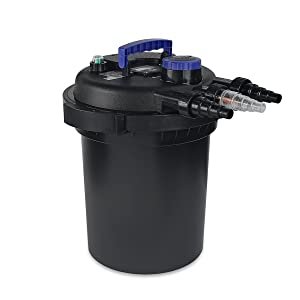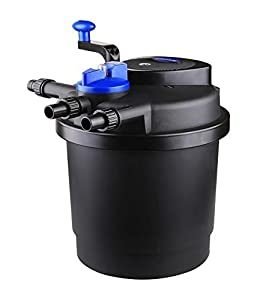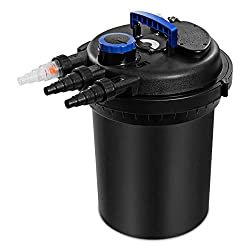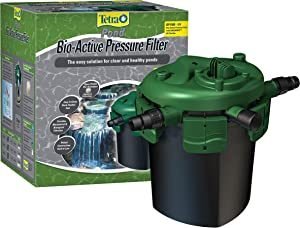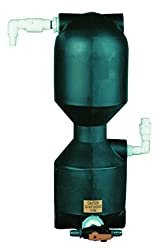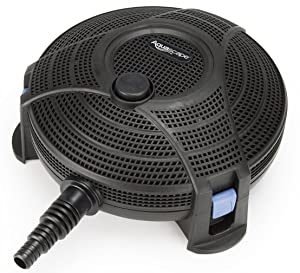One of the most important parts of any pond is the filtration system, and this is especially true when it comes to koi ponds as koi are notoriously messy fish. We’ve put together a list of the Best Filters for Koi Ponds to help you find the filter you need to offset the effect koi have on water quality and allow them to thrive.
Comparison Table
 Top Top Top Top | XtremepowerUS 10000L KOI Pond Fish Pressure Bio Filter 13W UV Sterilizer (2650 GPH) | 4/5 | Prime | View on AMAZON | |
 Top Top Top Top | OASE BioSmart 10000 Pond Filter | 4.5/5 | PrimeEligible | View on AMAZON | |
 Top Top Top Top | OASE BioSmart 5000 Pond Filter | 4.5/5 | PrimeEligible | View on AMAZON | |
 | Goplus Bio Pressure Pond Filter, 4000Gal | editable | Prime | Check Price | |
Top Top Top Top Top | Aqua Ultraviolet Ultima II 1000 Aquarium Filter with 2-Inch Valve | 4.2/5 | Prime | View on AMAZON | |
 Top Top Top Top | TetraPond Bio-Active Pressure Filter, For Ponds Up to 4000 Gallons | 4.3/5 | PrimeEligible | View on AMAZON | |
 Top Top Top Top | AST Bubble Bead Filter XS1000- Perfect for Koi Ponds Up to 1000 Gallons | 4/5 | Prime | View on AMAZON | |
 Top Top Top Top | Aquascape Submersible Pond Water Filter | 4.3/5 | PrimeEligible | View on AMAZON |
Having a reliable filter for your koi pond is so important to help ensure that the chemistry of the water environment remains balanced and healthy for your fish.
Choosing the right filter can be complicated, but to give you a hand, we go over the 10 best koi pond filters on the market today to make it a quick and painless process.
Top 10 Best Filter System for Koi Pond
Does a Koi Pond Need a Filter?

A koi pond absolutely needs a filter because as we mentioned, koi fish can be a little messy.
Depending on how many fish you have, the bioburden can increase exponentially in your pond every year. Using a reliable filter that works in conjunction with the pump can make sure any fish load and debris entering the environment is taken care of.
In the right conditions, a clean and healthy water environment, your koi can grow quite quickly.
Best Filter for Koi Pond Reviews
The right filter will keep your koi happy and healthy and your pond looking great.
Here are some of our researched and recommended filters.
1. XtremepowerUS 10000 Koi Pond Pressure Bio Filter UV Sterilizer
The XtremepowerUS 10000 Koi Pond Pressure Bio Filter is an extremely powerful option. It has a rate of up to 10,000 liters per hour and is suitable for ponds of approximately 1,500 gallons.
This filter includes 3 layers of sponges to create a perfect environment for growth of good bacterial colonies.
There are 3 different connections available: ¾ “, 1 ¼” and 1 ½ “. It also includes a 13 watt UV light to break up algae colonies, meaning you don’t have to worry about getting extra pieces. The 4.5 long power cord meters makes installation easy.
Benefits
- Powerful filter
- 3 layers of sponges
- Easy installation
Cons
- None that we can see
2. Oase BioSmart Koi Filter
The Oase BioSmart Koi Filter offers superior biological filtration for ponds with a large amount of koi.
This filter includes several biotic media filters, each with a large amount of surface area. The filters themselves are divided into several zones to facilitate the biological conversion of ammonia into nitrite.
This system is easy to clean thanks to an integrated cleaning indicator and sludge drain. All you need to do to clean it, is turn off the pump and pull the sludge drain handles.
However, we’ve noticed installation of the BioSmart filter is not easy compared to other systems due to inadequate instructions. There is also no UV filter built into this system to remove harmful bacteria.
Benefits
- Suits large amounts of koi
- Easy to clean
Cons
- Difficult installation
- No inbuilt UV filter
3. Oase BioTec Screenmatic Koi Filter Review
The sophisticated Oase BioTec Screenmatic Koi Filter provides some of the best biological and mechanical filtration for koi ponds and their unique “screening” feature greatly reduces clogging and general maintenance.
This system allows water entering the filter inlet to go through an initial screening process before it can enter the main chamber with a biological filter medium.
Debris collected during the screening process is automatically deposited in a separate holding tray via a rotating conveyor in a 30 minute process cycle. This high-tech feature may seem like a novelty at first glance, but in reality it provides truly efficient mechanical filtration and prevents debris from clogging bacteria and reducing oxygen content.
The screen system is a good width and would work well with all pond sizes, depositing debris every 30 minutes and allowing the beneficial bacteria to work without interruption.
Benefits
- Sophisticated screening system
- Less likely to clog or need general maintenance
Cons
- None that we can see
4. Grech CPF-2500 Pond Bio Pressure Filter
The Grech CPF-2500 Pond Bio Pressure Filter is powerful enough for a koi pond of up to 900 gallons and has a compact design that is easy to install and be hidden on the edge of the pond.
It uses mechanical and biological filtration and modern UV technology to keep the water clean.
This filter has a simple cleaning system that doesn’t require constant opening and foam cleaning, making maintenance quick and easy. It comes complete with inlet and outlet tubing adapters to make setup a little easier.
Benefits
- Compact design
- Simple installation and cleaning
- Includes UV technology
Cons
- None that we can see
5. Goplus Pressure Bio Filter (Budget Friendly Option)
This small Goplus Pressure Bio Filter offers excellent filtration for a wide variety of pond systems.
The inclusion of a 13-watt UV clarifier in this filter is a big plus, as it takes advantage of the slow flow of water to eliminate harmful bacteria and parasites. Cleaning is easy thanks to the simple design of the container housing, which unscrews and allows access to all internal components.
However, as with many pressurized filters, it may be necessary to add activated carbon to the filter medium if your pond has a large amount of koi, to help with water oxygenation.
Although this pump is effective and economical, some attention has to be given to the build quality. The filter housing appears to have occasional manufacturing problems and some units seem to leak.
GoPlus customer service has been very poor in responding to problems with the filter system and the company makes no guarantees.
Benefits
- Cheaper option
- Easy to clean
- Includes 13-watt UV clarifier
Cons
- Manufacturing problems
- Poor customer service
6. AquaUltraviolet Ultima II Bead Filter Review
The best pressurized bead filter for high density koi fish ponds is the AquaUltraviolet Ultima. Unlike classic pearl filters, this particular brand uses hollow halves of various sizes to avoid clumping, instead of a universal medium size type.
This design is much more effective at colonizing bacteria as it helps keep them healthy by preventing the accumulation of debris on the soil’s surface.
Pressurized filters can create a lower oxygen content in slow environments and beneficial bacteria will be discharged when using a classic “blower” backwash system. Ultima II attempts to solve these problems by modifying the way pressurized filters regulate water and clean themselves.
For example, this range of bead filters does not have a blower function, but instead uses a “blast” system that lifts and rotates the vehicle, effectively separating debris for easier removal through a line of debris. This system should keep most of the bacterial colonies intact, maintaining superior quality biofiltration during and after cleaning.
Benefits
- Bead filter system
- Effective at colonizing bacteria
- Uses a “blast” system
Cons
- None that we can see
7. Tetra Pond Bio-Active Pressure Filter with UV Clarifier
Another great option is the Tetra Pond Bio-Active Pressure Filter. It comes with a UV clarifier to break up the algae so they can be removed by mechanical and biological filtration. This system is unique as it uses bioactivators instead of foam.
Bioactivators trap debris and provide a large surface area for colonies of beneficial bacteria to grow. When the backwash function is used for cleaning, dirt and debris are quickly removed while the colonies of bacteria can remain intact.
This is a great filter for ponds up to 1500 gallons and should be used with pumps running at 2500 gallons to get the right amount of pressure for proper filtering and backwash. Also, avoid pumps that exceed 4500 gallons per hour, as they could damage the filter.
Benefits
- Uses bioactivators
- Can be used for bigger ponds
Cons
- Not applicable for pumps exceeding 4500 gallons p/h
8. Bubble Bead Filter XS-1000
This Bubble Bead Filter XS-1000 offers the easiest cleaning of any filtration system we’ve ever seen.
To clean it just a quick backwash, which is usually enough to reduce pressure build-up in the system without having to remove or replace any of the internal filters.
Fortunately, this backwash is gentle enough to avoid breaking the biofilm in the biological filter medium.
Like other bead filters, this unit specializes in mechanical filtration. AST claims that the unit can capture 100% of particles larger than 50 microns and half of all particles down to 5 microns, ensuring that the water remains clear.
However, keep in mind that this filter is not equipped with UV light to kill harmful bacteria.
The filter is available in sizes ranging from 300 to 20,000 gallons. While AST doesn’t offer a guarantee, you can expect five-star customer service from the company.
Benefits
- Easy to clean
- Efficient
- Good customer service
Cons
- UV light not included
9. OASE BioSmart 5000 Pond Filter
The OASE BioSmart 5000 Pond Filter setup is efficient and uses different zones to promote the effective growth of beneficial bacteria.
This would be a great option for a koi pond up to 1250 gallons, and the cleanliness indicator, temperature indicator, and sludge drain make it extremely easy to use.
Another big plus is the integrated cleaning mechanism. There is no need to manually remove or unblock the filter foams, so maintenance is really simple. Simply turn off the pump, lift the cleaning handles and let the dirt drain out.
Benefits
- Includes cleaning and temperature indicators
- Easy to clean
Cons
- None that we can see
10. Aquascape Submersible Pond Water Filter
The Aquascape Submersible Pod Water Filter is, as the name suggests, fully submersible. It has a large surface area for maximum filtration, but uses small openings to prevent the filter from becoming clogged with larger pieces of dirt. It’s also compatible with most submersible pumps and includes a multi-hose fitting.
Another way it helps prevent clogging is with a prefiltration sponge that provides mechanical and biological filtration. This prevents harmful debris from entering the pump, reducing maintenance time.
Plus, the ceramic rings used in this filter provide a large surface area for beneficial bacteria, helping to provide the levels of filtration needed for a koi pond. The removable cage also makes cleaning easier.
Benefits
- Fully submersible
- Prefiltration sponge
- Easy to clean
Cons
- None that we can see
Which Koi Pond Filter Is Best?
The best filter for your koi pond ultimately comes down to your specific needs and the filter systems we review offer pros and cons for many different types of ponds.
For example, the Aqua Ultraviolet Pearl Filter is a good choice for aquarists who want a pearl filter that doesn’t compromise biological filtration, but also doesn’t have a koi pond that exceeds the limits of a 6,000 gallon filter.
The Bubble Bead and Oase BioTec Screenmatic filters offer options for larger koi ponds, and both feature simple cleaning mechanisms.
Overall, our top choice for the best koi pond filter would be the OASE BioSmart 10000.
- Pond Size = 5000 or 10,000 gallons
- Filtration Stages = Biological & Mechanical
- Outlet Size = 2.5
- Dimensions = 30†x 22†x 16â€
Prices pulled from the Amazon Product Advertising API on:
Product prices and availability are accurate as of the date/time indicated and are subject to change. Any price and availability information displayed on [relevant Amazon Site(s), as applicable] at the time of purchase will apply to the purchase of this product.
How to Choose a Koi Pond Filter?
The first thing to consider when deciding on a koi pond filter is how much money you want to spend.
The filtration system is the most important feature of every pond. There are ways to save money when setting up a koi pond, but the filter is one area where you can’t afford to cut corners.
Calculate the Volume
The filtration you need is based on the volume of your pond. Naturally, the more water you have in your pond, the more filtration it takes to clean.
If you are using a hard plastic pond liner, it should tell you the exact volume. If you’re creating your own shape, figuring out the exact volume can be a bit tricky, but getting a close estimate is easy enough using the formula: Length x Width x Height.
Check your pond size here
Factor in Fish
It’s also important to take into account the fish that you are going to put in your pond. If you are going to have koi, you have to quadruple the volume of the tank.
Why?
Because koi produce a lot of debris, so the filtration system needs to work 4 times harder than with an empty pond to keep it clean. On the contrary, if you had goldfish, you would only have to double the volume.
It is also worth noting that the result of this calculation is a minimum amount. You should choose a filter that is as close to this figure as possible. For example, if you have a 400 gallon tank and 200 and 500 gallon filters are available, the 500 gallon option is the best option.
What about UV Filters?
In a pond filtration system, UV filters are responsible for making the algae easy to trap on filter sponges.
They do it by emitting ultraviolet light that forces the algae to clump together so they can be caught as they flow through the filter.
Some filters have a built-in UV clarifier, others will require a separate piece to be placed in-line. Both are effective, but it is important to know that there is more than one type available.
Choosing a Pump
Make sure that your filter and the pump are compatible. For the filtration system to work, the pump must have a flow rate that brings the correct amount of water to the filter.
Most pumps will clearly tell you how many gallons or liters per hour are running. If you match this to the volume of your tank, it means the entire pond will cycle every hour.
If you plan to place your pump on the surface of the pond, you will need one that is a little more powerful because it will have to pump the water out of the pond, working against gravity.
Getting the right filter size is important. Too weak and you won’t be able to cycle enough water. Too strong and the filter box could overflow.
Think about Electrical Components
Remember that pumps have many electrical components and that electricity and water can be dangerous together. Make sure to place your pond in an area where cables and cords can be safely placed.
If you want to be more cautious, consider investing in a breaker box to have a dedicated spot to safely run your electronics.
How to Set Up a Koi Pond Filter System?
Naturally, we recommend following the filter’s manufacturer-specific instructions. But generally, there are a few basic steps they all have in common.
The first thing to do is to determine the layout of the pond, bearing in mind that you need to integrate the filter, pump and pipes into the layout.
Then, lay the necessary pipes to create a closed loop system, from the pump to the filter and back to the pond. Depending on the design, this can be very broad or very simple.
After you’ve laid the pipes, it’s time to set up the electrical components. Each pump has its own requirements, but most run on standard 100-volt household power. Check pump details for wire size and switches.
Also, remember that any electrical cable used outdoors requires protection from the elements and must be routed through a conduit.
When the power is set, it’s time to put the pump and filter in place and make the final connections. Turn on the pump and make sure it is working properly. If not, start troubleshooting by verifying that all connections are secure.
Koi Pond Filters FAQs
How do I choose a pond filter?
- You need a filter that matches the size of your pump. The maximum flow rate of the filter must be equal to, or more than, the maximum flow rate of the pump.
Can I use a pool pump for a koi pond?
- No, swimming pool pumps are just what a swimming pool needs, and a koi pond needs a koi pond pump.
Are koi ponds high maintenance?
- Koi fish may be known for their grace and beauty, but they are also one of the dirtiest and high-maintenance fish to own. They like to root up the pond’s bottom surface and produce a lot of waste, creating a mucky pond environment.
Final Comments
Koi ponds are beautiful additions to any backyard, but because koi soil the water quickly, proper filtering is important for keeping the pond clean and the fish healthy. There are many great options for the Best Koi Pond Filters to suit your specific pond needs.
.


